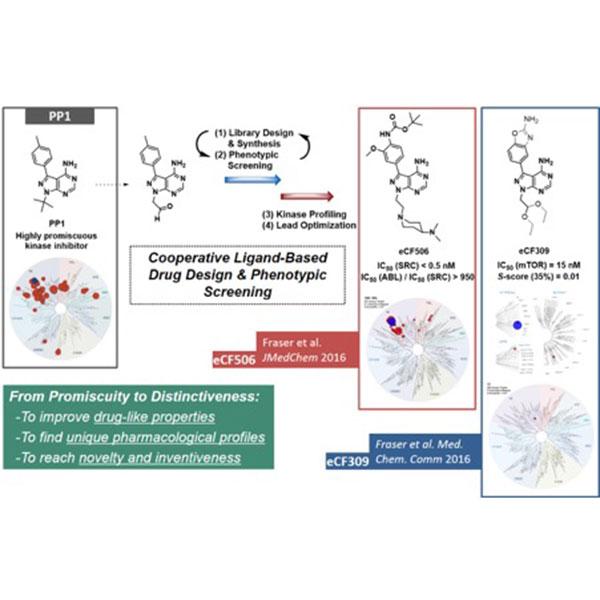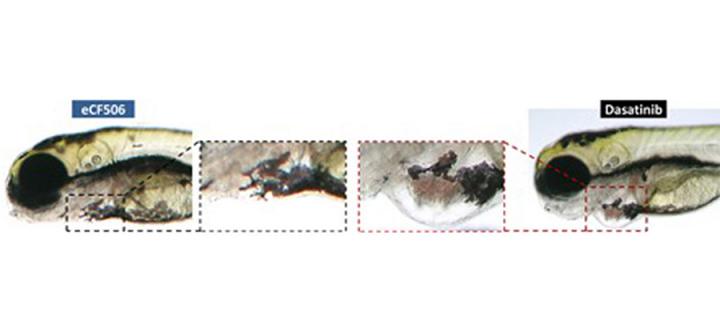Asier Unciti-Broceta: Innovative Therapeutics
Research Programme

Palladium-Activated Prodrug Therapy
Inspired by the notion of bioorthogonality coined by Carolyn Bertozzi (Stanford University), our lab focuses on the exploration and development of masking strategies capable of suppressing the bioactivity of chemotherapeutics and rendering them biochemically stable while “activatable” through highly-selective bioindependent processes. Specifically, we are investigating the development of BioOrthogonal OrganoMetallic (BOOM) reactions mediated by metallic Palladium (Pd) [1, 2], a nonbiological catalyst that shows remarkable safety in cell culture and in vivo. This novel paradigm has created a new field of research that aims to exploit the selective reactivity and high biocompatibility of some transition metal catalysts such as Pd in chemical biology and biomedicine. Our work on Pd-labile precursors of cytotoxic pyrimidine analogues (see Fig 1A) was the first to demonstrate that non-biological transition-metal catalysts can be safely used to transform inactive chemicals into potent drugs in cell culture [3]. Following a series of studies [3-6], which was developed in collaboration with Prof Carragher and Dr Patton, we also proved that devices containing high quantities of Pd are fully compatible with developing animals and can induce local activation of chemical probes (Fig 1B). Our lab is actively engaged on the development of novel BOOM reactions mediated by heterogeneous palladium catalysts and in exploiting such reactions for the activation of drug precursors in a spatially-controlled manner, i.e. as a local therapeutic strategy for the treatment of glioblastoma multiforme and prostate cancer.
Cooperative Ligand-Based Drug Design and Phenotypic Screening

In the search for hits and leads that could target a wide range of kinases with relevance in cancer, we employ highly promiscuous kinase inhibitors as templates to design small molecule collections and to facilitate the search for enhanced physicochemical properties and, at the same time, the exploration of novel pharmacological features. To accelerate the discovery of bioactive inhibitors, our lab frontloads phenotypic analysis using selected cancer cell lines to guide subsequent chemical design towards specific cancer indications. By performing ligand-based design, library synthesis and phenotypic screening in an iterative manner (see Figure 2), we facilitate the discovery of compounds with anticancer properties —regardless of the target involved— and suitable physicochemical properties to enter cells.

In the proof of concept studies [7, 8], chemical design was biased towards breast cancer treatment (rather than to a particular target) by using human breast cancer cells as a discriminating cell model. Such pseudo target-agnostic strategy enabled the rapid identification of compounds that inhibited pathways involved in breast cancer survival and cell invasion and also disregarded compounds with low cell penetrability. Using this pragmatic approach, target deconvolution of identified hits and leads was largely simplified (= focused kinome screening), thereby assisting the mechanistic elucidation of the molecular targets and antitargets involved in the observed phenotype. This led to the discovery of novel ATP-competitive kinase inhibitors with unique properties, including the exquisitely selective mTOR inhibitor eCF309 [1] and the orally-available SRC inhibitor eCF506 [8], which is the first small molecule with subnanomolar IC50 for SRC that requires 3 orders of magnitude greater concentration to inhibit ABL. This is of relevance because the manifestation of cardiac events -especially in elderly patients- is a well-established adverse effect of ABL inhibition and many studies have shown that ABL plays a paradoxical anti-oncogenic role in breast cancer. Such off-target activities are absent in eCF506, which exhibits excellent water solubility and an optimal DMPK profile, halts SRC-associated neuromast collective cell migration in zebrafish embryos without inducing life-threatening heart defects and inhibits in vivo SRC phosphorylation in tumor xenografts [8].
Key References
- Yusop, Unciti-Broceta, Sánchez-Martín, Johansson & Bradley*. Palladium-Mediated Intracellular Chemistry. Nat. Chem. 2011, 3, 241-245.
- Unciti-Broceta*, Johansson, Sánchez-Martín & Bradley*. Synthesis of Polystyrene Microspheres and Functionalization with Pd0 Nanoparticles to Perform Bioorthogonal Organometallic Chemistry in Living Cells. Nat. Protocols 2012, 7, 1207-1218.
- Weiss, Dawson, Macleod, Fraser, Ribski, Torres-Sánchez, Patton, Bradley, Carragher & Unciti-Broceta*. Extracellular Palladium-Catalyzed Dealkylation of 5-Fluoro-1-Propargyl-Uracil as a Bioorthogonally-Activated Prodrug Approach. Nat. Commun. 2014, 5, 3277.
- Weiss, Dawson, Fraser, Rybski, Torres-Sánchez, Bradley, Patton, Carragher & Unciti-Broceta*. Development and Bioorthogonal Activation of Palladium-Labile Prodrugs of Gemcitabine. J. Med. Chem. 2014, 57, 5395-5404.
- Weiss, Carragher & Unciti-Broceta*. Palladium-Triggered Dealkylation of N-Propargyl-Floxuridine as a Bioorthogonal Oxygen-Independent Prodrug Strategy. Sci. Rep. 2015, 5, 9329.
- Unciti-Broceta*. Rise of the Nanobots. Nat. Chem. 2015, 7, 538–539.
- Fraser, Carragher and Unciti-Broceta. eCF309: a potent, highly-selective, cell-active mTOR inhibitor. MedChemComm 2016, 7, 471-477.
- Fraser et al. Rapid Discovery and SAR of Pyrazolopyrimidines that Potently Suppress Breast Cancer Cell Growth via SRC Inhibition with Exceptional Selectivity over ABL. J. Med. Chem. 2016, 59, 4697–4710.

